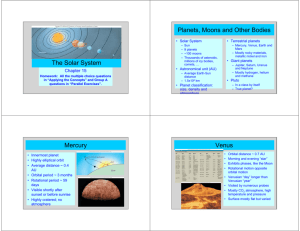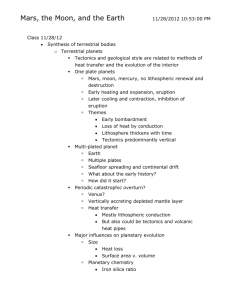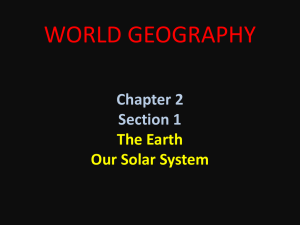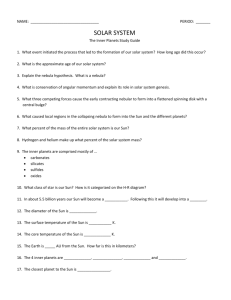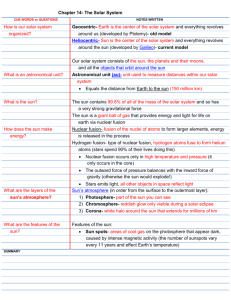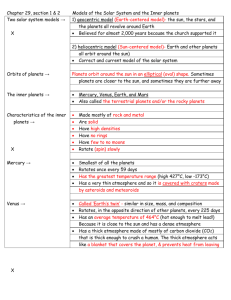The Solar System Review - Stephanie Dietterle Webpage
advertisement
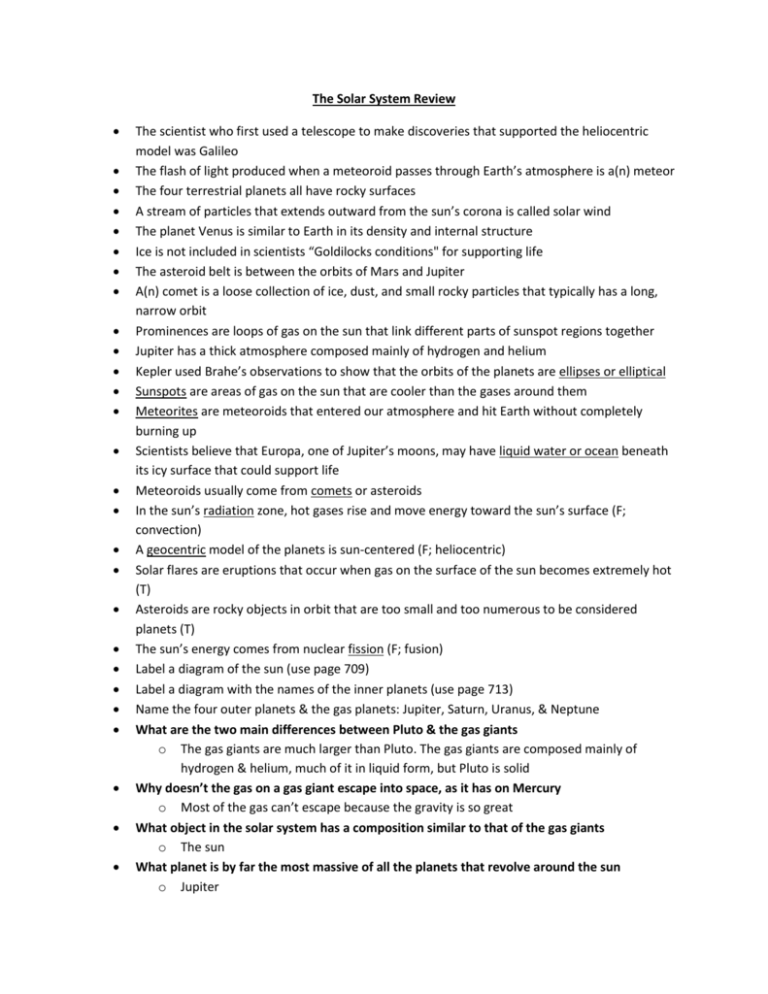
The Solar System Review The scientist who first used a telescope to make discoveries that supported the heliocentric model was Galileo The flash of light produced when a meteoroid passes through Earth’s atmosphere is a(n) meteor The four terrestrial planets all have rocky surfaces A stream of particles that extends outward from the sun’s corona is called solar wind The planet Venus is similar to Earth in its density and internal structure Ice is not included in scientists “Goldilocks conditions" for supporting life The asteroid belt is between the orbits of Mars and Jupiter A(n) comet is a loose collection of ice, dust, and small rocky particles that typically has a long, narrow orbit Prominences are loops of gas on the sun that link different parts of sunspot regions together Jupiter has a thick atmosphere composed mainly of hydrogen and helium Kepler used Brahe’s observations to show that the orbits of the planets are ellipses or elliptical Sunspots are areas of gas on the sun that are cooler than the gases around them Meteorites are meteoroids that entered our atmosphere and hit Earth without completely burning up Scientists believe that Europa, one of Jupiter’s moons, may have liquid water or ocean beneath its icy surface that could support life Meteoroids usually come from comets or asteroids In the sun’s radiation zone, hot gases rise and move energy toward the sun’s surface (F; convection) A geocentric model of the planets is sun-centered (F; heliocentric) Solar flares are eruptions that occur when gas on the surface of the sun becomes extremely hot (T) Asteroids are rocky objects in orbit that are too small and too numerous to be considered planets (T) The sun’s energy comes from nuclear fission (F; fusion) Label a diagram of the sun (use page 709) Label a diagram with the names of the inner planets (use page 713) Name the four outer planets & the gas planets: Jupiter, Saturn, Uranus, & Neptune What are the two main differences between Pluto & the gas giants o The gas giants are much larger than Pluto. The gas giants are composed mainly of hydrogen & helium, much of it in liquid form, but Pluto is solid Why doesn’t the gas on a gas giant escape into space, as it has on Mercury o Most of the gas can’t escape because the gravity is so great What object in the solar system has a composition similar to that of the gas giants o The sun What planet is by far the most massive of all the planets that revolve around the sun o Jupiter What are Saturn’s rings made of o Chunks of ice & rock How did astronomers know where to look to discover Neptune o Neptune’s orbit was predicted by mathematicians who calculated its location by its effect on the orbit of Uranus How is Pluto now classified o As a dwarf planet Location & Movements of Asteroids, Comets, Meteoroids o Asteroids: most revolve around the sun between the orbits of Mars & Jupiter o Comets: orbits the sun in a long narrow ellipse o Meteoroids: moves through the solar system; if formed from a comet it would have similar elliptical orbits Explain what causes a meteoroid to become a meteorite o A meteoroid enters Earth’s atmosphere and friction causes it to heat up. If the meteoroid is large enough, it does not completely burn up and it hits Earth’s surface Describe these parts of a comet: head, nucleus, coma, tail o The head is made up of the nucleus and coma. The nucleus is the solid inner core. The coma is the fuzzy outer layer formed by clouds of gas and dust. The tail is the gas from the comet that streams outward as the comet approaches the sun How can you tell a meteor from a comet o Comets are visible for days or weeks but a meteor is a quick flash of light that moves across the sky Using the names of the inner planets: Mercury, Venus, Earth, Mars; describe each statement o Has a rocky surface: mercury, venus, earth, mars o 70% is covered by water: earth o Rotates in the opposite direction from most other planets and moons: venus o Called the “red planet” because of the color of the dust: mars o Has at least one moon: earth, mars o Similar to each other in size, density, and internal structure: venus, earth o Has almost no atmosphere: mercury o Atmosphere is so heavy and thick that it would crush a human: venus o Has a tilted axis that causes seasons: earth, mars o Atmosphere has low air pressure and is mostly carbon dioxide: mars Vocabulary Words o Solar flare: an eruption of gas from the sun’s surface that occurs when the loops in sunspot regions suddenly connect o Core: the central region of the sun, where nuclear fusion takes place o Chromosphere: the middle layer of the sun’s atmosphere o Sunspot: a dark area of gas on the sun’s surface that is cooler than surrounding gases o Corona: the outer layer of the sun’s atmosphere o Nuclear fusion: the combining of two atomic nuclei to produce a single larger nucleus and much energy o Photosphere: the inner layer of the sun’s atmosphere that gives off its visible light o Solar wind: a stream of electrically charged particles that emanates from the sun’s corona o Prominence: a huge, reddish loop of gas that protrudes from the sun’s surface, linking parts of sunspot regions o Radiation zone: a region of very tightly packed gas in the sun’s interior where energy is transferred mainly in the form of light o Convection zone: the outermost layer of the sun’s interior o Terrestrial Planets: the names often given to the four inner planets: mercury, venus, earth, mars o Greenhouse Effect: the process by which heat is trapped in the atmosphere by water vapor, carbon dioxide, methane, and other gases that form a “blanket” around Earth; the trapping of heat by a planet’s atmosphere o Gas Giant: the name often given to the first four outer planets: Jupiter, Saturn, Uranus, Neptune o Ring: a thin disk of small ice and rock particles surrounding a planet o Asteroid: rocky objects revolving around the sun that are too small and numerous to be considered planets o Asteroid belt: the region of the solar system between the orbits of Mars & Jupiter, where many asteroids are found o Coma: the fuzzy outer layer of a comet o Comet: a loose collection of ice, dust, and small rocky particles, typically with a long, narrow orbit of the sun o Kuiper belt: a doughnut shaped region that stretches from around Pluto’s orbit to about 100 times Earth’s distance from the sun o Meteor: a streak of light in the sky produced by the burning of a meteoroid in Earth’s atmosphere o Meteoroid: a chunk of rock or dust in space o Meteorite: a meteoroid that passes through the atmosphere and hits Earth’s surface o Oort cloud: a spherical region of comets that surrounds the solar system
